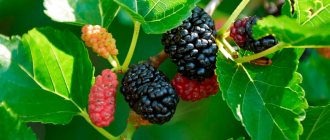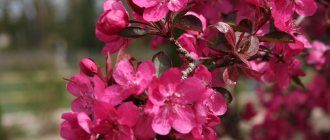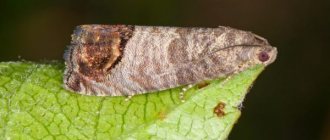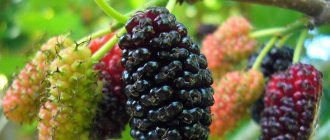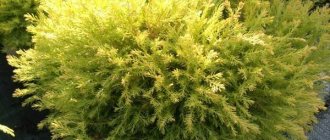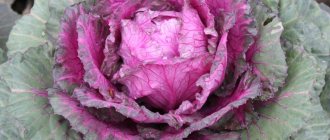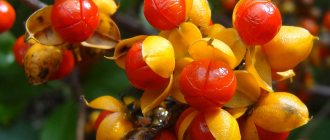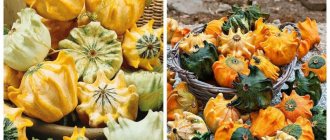Mulberry is a beautiful tree that is popular among summer residents in Russia. There are several varieties of this tree. Weeping mulberry differs in size and shape of the crown. Externally, its hanging branches resemble a weeping willow or willow.
Description of the weeping mulberry
Deciduous tree of the mulberry family. No more than 3 m in height. 17 species of mulberry tree are officially described, although there are more than 200 varieties of mulberry.
This is not only an ornamental plant, but also a fruit tree with tasty and aromatic berries. Its compact size makes it possible to grow weeping mulberries even in a small area. The crown reaches 2 m in width. The branches of the weeping mulberry are long and capable of growing to the ground.
The plant is a long-liver and can decorate a site for 200-500 years. The fruits are represented by a drupe, hidden by a fleshy perianth. Fruit length - 2-5 cm. Color - pink, dark purple, white. The fruits are edible, sweet and sour with a pleasant aroma.
The weeping mulberry in the photo attracts with its fruits. These are juicy berries with an unforgettable aroma and sweet taste. The fruits of the weeping mulberry are very healthy and contain vitamins and microelements. The tree is also suitable for decorative purposes.
The mulberry will ripen by mid-summer. In winter, after the tree has shed its leaves, the bend of the branches will please the eye and give the plant a special grace.
Description and varieties
The mulberry tree grows in Japan, China, India, and Turkey. From time immemorial it has been considered medicinal and valued for its healing properties. Also, mulberry leaves are used in the production of silk material. The plant's distribution area is vast; it can be found in the Moscow and Leningrad regions, in the Middle Volga region. Below are some more facts about the weeping mulberry:
- there are more than two hundred varieties;
- deciduous fruit plant;
- sweet and sour fruits (up to five centimeters long) - pink, purple, white berries (drupes with a fleshy perianth);
- due to its small size, it can be grown in a small area;
- crown width - two meters;
- long life expectancy (up to five hundred years).
Varieties of weeping decorative mulberry
Weeping mulberry is a common mulberry that has several varieties. They differ in fruit color, size, and ripening time.
The most popular variety is the weeping mulberry Black Baroness. This is a black variety of weeping mulberry with large fruits up to 4 cm. It easily tolerates frosts down to -30 °C. Productivity - up to 100 kg per tree. Weeping mulberry Black Baroness has the most positive reviews about its unsurpassed taste.
White weeping mulberry is another species. It has heart-shaped leaves. Flowering period is May-June. The fruits are white, sweet, and do not tolerate transportation well.
For the most part, weeping mulberries have lower yields than other mulberry varieties. Mainly used to decorate a site, it is often planted near gazebos, fences, and also as single plantings in the garden.
Distinctive features of the plant
The spherical mulberry has certain characteristics:
- This tree is quite short and can reach a height of 3 to 5 meters. Its branched crown has the shape of an umbrella, since the branches hang low to the ground; it can also grow up to 3 - 5 meters in width.
- The leaves are dark green in color, they are large in size, their length can reach 8 - 20 centimeters. The leaves are shaped like a heart and have a glossy surface. They are smooth on top and rough to the touch below.
- The flowers are small and inconspicuous; they are not particularly beautiful and do not affect the appearance of this plant. The mulberry tree blooms from May to June.
- The fruits appear on the mulberry tree from June to July; they are small in size, have a glossy surface and are black in color. In appearance, mulberries resemble blackberries.
- This plant has a strong root system, which allows it to receive sufficient moisture even in very dry summers.
The main benefits of weeping mulberry
A list of advantages that this plant has compared to other fruit and berry trees will help you make a choice in favor of purchasing a mulberry tree:
- A long-lived plant - can live 200 - 300, or even more years. Therefore, by planting such a tree once and caring for it properly, you can get a family treasure and heirloom that will delight more than one generation of relatives with its tasty and nutritious fruits.
- Decorative properties - mulberry on a trunk can be grown as an ornamental plant, forming hedges and fences. It is also planted as a single tree or as a green decoration for gazebos. By giving the mulberry crown a different shape, you can get an extraordinary decoration for your garden plot; in the spring it will be green, and with the onset of autumn it will gradually acquire a yellow color.
- Due to the fact that this plant is not picky about the soil, it can be grown in various areas without requiring excessive care and maintenance.
- Frost-resistant tree - easily tolerates harsh winters without freezing. It does not need to be covered with the onset of winter cold.
- It is drought-resistant - thanks to its developed root system, it does not require a huge amount of moisture and copes well with dry periods.
- Mulberry can also be used to strengthen slopes, ravines, and consolidate sand.
- The healing properties of mulberry fruits make it possible to cope with various diseases and are used as herbal medicine.
Planting and caring for weeping mulberry
Weeping mulberry on a trunk does not require care. But there are points that should be taken into account when planting and cultivating crops. When it comes to planting and care, weeping mulberry is not a capricious plant.
Selection and preparation of a landing site
Loamy and sandy loam soils are optimal for planting weeping mulberries. The site is chosen to be as illuminated as possible, with plenty of sunlight. There should be no tall trees or buildings nearby that cast shadows.
It is better to plant decorative mulberries on the southern slopes of hills.
Mulberry grows poorly on saline soils, as well as in swampy areas. The seedling should not be exposed to cold winds.
Preparation of planting material
Weeping mulberry propagates through cuttings. They are cut at the beginning of summer from this year's growth. With proper planting and compliance with the rules of agricultural technology, such cuttings will take root by autumn. It is important to plant them at an angle of 45°.
If a seedling with a ready-made root system is purchased for planting, then when purchasing you should pay attention to the condition of the roots. The roots of young mulberries are weak. It is important that there are no sick or rotten specimens among them. It is optimal if the roots are not dry and packed in fertile soil. Then the weeping mulberry will quickly take root, and care will not be difficult.
Planting weeping mulberries
It is recommended to plant a tree in the spring. But it is advisable to prepare the hole for planting in the fall. The width and height of the recess is 50 cm. When digging, instead of the infertile layer, you need to fill in a couple of buckets of compost or humus.
Place 50 g of urea, 100 g of superphosphate and 50 g of potassium in the pit. Mix with fertile soil.
When planting, the roots are carefully straightened. If planting is carried out in the southern regions, then the seedling is buried to the root collar. In the Northern regions, it is recommended to deepen the neck 5 cm below the soil level. The distance between seedlings should be 3 m.
After planting, trees are immediately watered. Each seedling needs 2 buckets of water. Then, to preserve moisture, the root zone is mulched. This can be done with straw, peat, sawdust or leaves.
Watering and fertilizing
Weeping mulberry is a very moisture-loving plant. Young plants need especially a lot of water. Immediately after planting, 2-3 buckets of water are poured onto the seedling.
Young trees are watered once every 2 weeks. In too hot summers, watering becomes more frequent up to once a week. The watering rate for a young mulberry tree is 20 liters. During the rainy season, you should not water the mulberry tree.
At the end of September it is necessary to carry out moisture-charging irrigation. To do this, pour 3 buckets of water under the young tree at once.
An adult plant requires less moisture. Weeping mulberry can also tolerate drought. Therefore, in hot weather, you can water mulberry trees once every 2 weeks or even less often.
Young weeping mulberry does not need feeding. Nutrient soil is sufficient for the first 2 years of life.
As you grow older, you need to apply fertilizer 2 times per season:
- The first feeding is carried out in the spring, while still lying on the snow. Urea is spread on the snow layer at the rate of 50 g per square meter. Some gardeners use ammonium nitrate instead of urea.
- In mid-August, potassium and phosphorus are added. This will help the mulberry overwinter and increase its frost resistance.
With such a fertilizing system, the mulberry will look impressive and give a decent harvest.
Protection from diseases and pests
Disease resistance is not observed in weeping mulberries. Therefore, it is necessary to carry out preventive treatment. It is best to do this in April, before the buds bloom.
Professional insecticides and fungicides are used for treatment. In October, a 3% solution of Bordeaux mixture is used.
Be sure to regularly carry out sanitary pruning to rid the plant of diseased shoots. They become the source of infection of the entire mulberry tree.
Preparing weeping mulberries for wintering
Preparation for winter begins in mid-autumn. For a young mulberry tree, it is necessary to press the branches to the ground. If mulberries are grown in a region with harsh winters, then for the first few years you need to wrap the trunk with warm material. It is also better to cover the root system and cover it with mulch on top.
In the southern regions, no special preparation is required, since mulberry tolerates southern winters without difficulty.
Preparing for winter
They begin to prepare for the winter cold in October. In the northern regions, young branches are pressed to the ground, wrapped in warm fiber, the roots are covered and mulched. As for the southern regions, additional preparation is not necessary. The mulberry will cope on its own without outside intervention.
Weeping mulberries can be found in parks and alleys. It is often used as a hedge. But there is a small nuance that should not be forgotten. Mulberry fruits can accidentally stain a white blouse or light-colored shoes if they are not collected in a timely manner.
Therefore, when planting a plant, you should decide on the goals of its breeding. If you do not plan to harvest the crop, you can plant ornamental trees that do not produce fruit. Otherwise, timely harvesting and care of the surrounding area is simply necessary.
Yield of weeping mulberry from one tree
The first harvest from the weeping mulberry, as in the photo, can be obtained only after 3 years. In the first year of harvest, the fruits will be small. There is no need to climb a tree when picking berries. It is enough to wait for ripening, then all the berries will fall to the ground. It’s just advisable to lay down any material in advance, preferably polyethylene.
From one tree, depending on the variety, you can collect up to 100 kg of mulberries.
When to plant mulberries
Modern frost-resistant varieties make it possible to grow mulberry trees in mid-latitude climates, in some regions of Siberia and the Urals. You can plant seedlings in a permanent place in autumn and spring. The choice of timing directly depends on the climate of the area and the availability of planting material.
If you managed to purchase a seedling in the fall, then you need to take into account that it must take root before the onset of cold weather - in the later stages, a young, poorly rooted plant may suffer from frost. Autumn planting, moreover, makes it possible to cull weak plants, because they will not survive the winter.
Where winters are very cold, it is better to postpone planting to spring. In spring, mulberries are planted as soon as the soil, prepared in the fall, thaws and warms up. In regions with warm climates, planting occurs in April or late September-early October.
V. Shalamov and G. Kazanin, both experienced gardeners, spoke in detail about growing mulberries in cold climates in their works.
How to form a weeping mulberry
Mulberry pruning is carried out to form the crown, remove diseased shoots, and also to rejuvenate the entire tree.
For pruning, you need to prepare tools, including pruning shears and a hacksaw. All tools must be sharpened and of high quality.
To form it, you need to leave a standard one meter high and cut off all the shoots at this distance. This pruning is carried out in early spring before the buds open. The temperature should not drop below - 10 °C.
Weeping mulberry is characterized by the same height and length of shoots. The central shoot is not isolated during crown formation. It is necessary to prune the branches at the lower and lateral buds. This creates the desired bend, which is considered characteristic of this shape.
Application in landscape design
Weeping mulberries are often used for decorative purposes. They use it to landscape alleys, squares, and garden plots. Thanks to the long branches hanging to the ground, it looks original even in winter. You can shape and trim the crown shorter - in the shape of an umbrella.
In small areas of private houses it looks good in a composition with evergreen thujas of different heights and shapes. In order not to stain the asphalt or the ground under the tree, special varieties have been bred that practically do not bear fruit.
Reproduction of weeping mulberries
Weeping mulberry is a dioecious plant, with both male and female flowers on the same tree. Mulberry propagation is possible by several methods:
- seeds - a long and labor-intensive process;
- green cuttings - the most common method;
- layering and maternal shoots;
- vaccination.
Each method has its own nuances. By grafting on one tree you can get a harvest of berries of different colors. This makes the tree even more decorative.
Mulberry pests and their control
Not too often, but from time to time, mulberry trees are affected by insect pests, which primarily include spider mites, American butterflies, mulberry moths and Comstock scale insects.
The white American butterfly is the most dangerous pest. Its greenish-brown caterpillars with black warts and yellow-orange stripes on the sides can eat all the leaves on a tree. Spider nests should be cut off and burned, hunting belts should be installed on tree trunks, and the mulberry crown should be treated with Chlorophos.
The mulberry moth, or rather its caterpillars, also feed on mulberry leaves. To protect the tree from them, it is sprayed with Chlorophos in the spring, at the time of swelling of the buds - it is at this time that the moth caterpillars appear.
Spider mites, settling on mulberry, produce the finest web, which is a sign of the presence of these tiny, invisible to the eye, but very dangerous pests. Ticks feed on the cell sap of mulberry leaves, making punctures in them, which causes the leaves to turn brown and fall off after some time. But the worst thing is that spider mites carry incurable viral diseases. Insecticides are not effective against ticks, which are arachnid insects; they are destroyed with acaricidal drugs - Kleschevit, Actellik and the like.
The Comstock mealybug is also a sucking insect that settles in the bark of a tree, on its leaves and branches and feeds on their sap, weakening the plant. As a result of its vital activity, wounds and tumors form on the mulberry, the branches become deformed and dry, and the leaves turn yellow and fall off. Scalebugs are destroyed by treating damaged plants with pesticides.
Reviews of weeping mulberry
Kiriyak Ruslan, 40 years old, Bendery
In our city, mulberries are used for landscaping. It is located on the sides of roads, in all parks and squares. Even in winter, without leaves, it looks great thanks to its graceful curves. I planted Black Baroness in my yard. It produces an excellent harvest with large berries measuring 4-5 cm. Children eat it with pleasure, and I make wine from mulberries.
Sokolov Dmitry, 38 years old, Krasnodar
Mulberries are grown for decorative purposes. Great for decorating the yard. Easy to care for, if the summer is rainy, you don’t even need to water it. I fertilize twice a season - that's enough. The main thing when landing is to choose the right place. If there is enough sun, the tree looks gorgeous and is always pleasing to the eye. The fruits are black, large, tasty and tolerate transportation well.
Mulberry diseases and their treatment
In general, mulberry is quite resistant to various diseases, but sometimes it also gets sick. Most often, gardeners have to deal with diseases such as powdery mildew, cylindrosporiosis, or brown leaf spot, bacteriosis and curly leaf blight. Damages mulberry and tinder fungus.
Powdery mildew is caused by a fungus and appears as a whitish coating on the leaves and shoots of mulberries. The disease progresses in dry weather; the disease develops especially quickly in thickened crowns. When the first signs of the disease appear, the mulberries are treated with Fundazol, Bordeaux mixture or a suspension of colloidal sulfur. As a preventive measure, one can consider collecting and burning fallen leaves in the fall.
Cylindrosporiosis, or brown leaf spot, is also a fungal disease, the symptoms of which are purple-red spots with a ring border that appear on the leaves. As the disease progresses, the leaf tissue inside the spot falls out, the leaves turn yellow and fall off. When the first signs of the disease appear, and then two weeks later, the plant is sprayed with a one percent Silit solution, spending up to 3 liters of solution per tree.
Bacteriosis mostly affects young leaves and shoots of mulberry, disfiguring them with spots of irregular shape, which become black as the disease progresses. Mulberry leaves curl and fall off, the shoots become deformed and become covered with gum-like clots. Against bacteriosis, mulberries are treated with Fitoflavin or Gamair, but, unfortunately, this does not always help, so the best way to protect the plant from bacteriosis is preventive measures.
Small leaf curl is a viral infection transmitted by insects. The disease manifests itself by wrinkling of the leaf plate between the veins, followed by granular nodularity. As a result, the leaves curl and shrink, the shoots become rough and brittle, although their number increases abnormally. Unfortunately, this disease is incurable, but as a preventive measure it is recommended to combat insects that carry viral infections, which primarily include sucking pests - aphids, thrips, mites and the like.
Polypore is a fungus that settles on trees and destroys their wood. Polypore spores penetrate cracks and damage in the bark and parasitize the tree, destroying its trunk. The mushroom must be cut out along with part of the wood and burned, and the wound must be treated with a five percent solution of copper sulfate, and then covered with a specially prepared mixture consisting of clay, lime and cow dung in a ratio of 1: 1: 2. If you find mechanical damage on a tree from which gum is oozing, to avoid further problems, clean this area, disinfect it with a one percent solution of copper sulfate and treat it with a mixture of Nigrol (7 parts) and sifted wood ash (3 parts).
Properties of mulberries - benefits and harms
Beneficial features
The medicinal properties of mulberry are due to the substances included in its composition - vitamins A, K, E and C, trace elements selenium, iron, manganese, zinc and copper, macroelements phosphorus, magnesium, calcium, potassium and sodium. Ripe mulberry fruits contain riboflavin, pantothenic and folic acids, tocopherol, pyridoxine and choline.
In folk medicine, mulberries are used to treat many diseases: ripe berries, which have a laxative effect on the body, treat constipation, and green ones, on the contrary, are used for diarrhea, as well as heartburn. Mulberry juice diluted with boiled water is used as a gargle for throat diseases. And an infusion of bark and berries is effective for acute respiratory infections, bronchitis, and bronchial asthma.
The diuretic property of a decoction of mulberry roots and bark is used for hypertension, and an infusion of leaves is used as an antipyretic for fever. People with heart disease and myocardial dystrophy are recommended to consume mulberry berries in large quantities - 300 g 4 times a day for a month.
For stress and insomnia, it is recommended to use a decoction of dry mulberries, since they contain a high content of B vitamins, which affect protein and carbohydrate metabolism and support the functioning of the nervous system.
It is recommended to consume mulberry during physical overload and during the recovery period after surgery, since the magnesium, potassium and quercetin contained in its berries have a beneficial effect on hematopoiesis.
In Vietnam, the drug Fomidol is produced from mulberry leaves, used to treat rheumatism and skin diseases.
Mulberry bark powder mixed with oil promotes rapid healing of bruises, cuts, ulcers and wounds, and lubricated with the juice of fresh mulberries several times a day, ringworm will disappear without a trace. But the main benefit of mulberry is that it ranks high in potassium content, therefore it is used for hypokalemia - a deficiency of this essential element in the body.
Contraindications
Harm to mulberry may occur in case of individual intolerance. Sometimes digestive disorders occur due to overeating or eating unripe mulberries. In addition, you should know that mulberry berries and juice do not combine well with other fruits and juices, causing fermentation in the intestines, so they, like melon, should be consumed separately - two hours before or two hours after another meal.
